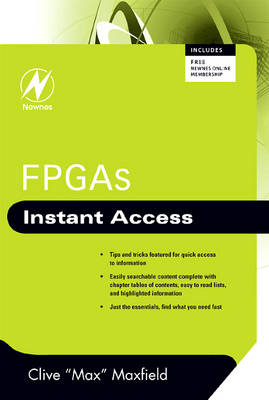Instant Access
2 total works
All the design and development inspiration and direction a harware engineer needs in one blockbuster book! Clive "Max" Maxfield renowned author, columnist, and editor of PL DesignLine has selected the very best FPGA design material from the Newnes portfolio and has compiled it into this volume. The result is a book covering the gamut of FPGA design from design fundamentals to optimized layout techniques with a strong pragmatic emphasis. In addition to specific design techniques and practices, this book also discusses various approaches to solving FPGA design problems and how to successfully apply theory to actual design tasks. The material has been selected for its timelessness as well as for its relevance to contemporary FPGA design issues.
Contents
Chapter 1 Alternative FPGA Architectures
Chapter 2 Design Techniques, Rules, and Guidelines
Chapter 3 A VHDL Primer: The Essentials
Chapter 4 Modeling Memories
Chapter 5 Introduction to Synchronous State Machine Design and Analysis
Chapter 6 Embedded Processors
Chapter 7 Digital Signal Processing
Chapter 8 Basics of Embedded Audio Processing
Chapter 9 Basics of Embedded Video and Image Processing
Chapter 10 Programming Streaming FPGA Applications Using Block Diagrams In Simulink
Chapter 11 Ladder and functional block programming
Chapter 12 Timers
Contents
Chapter 1 Alternative FPGA Architectures
Chapter 2 Design Techniques, Rules, and Guidelines
Chapter 3 A VHDL Primer: The Essentials
Chapter 4 Modeling Memories
Chapter 5 Introduction to Synchronous State Machine Design and Analysis
Chapter 6 Embedded Processors
Chapter 7 Digital Signal Processing
Chapter 8 Basics of Embedded Audio Processing
Chapter 9 Basics of Embedded Video and Image Processing
Chapter 10 Programming Streaming FPGA Applications Using Block Diagrams In Simulink
Chapter 11 Ladder and functional block programming
Chapter 12 Timers
FPGAs are central to electronic design! The engineers designing these devices are in need of essential information at a moment's notice. The Instant Access Series provides all the critical content that a computer design engineer needs in his or her daily work.
This book provides an introduction to FPGAs as well as succinct overviews of fundamental concepts and basic programming. FPGAs are a customizable chip flexible enough to be deployed in a wide range of products and applications. There are several basic design flows detailed including ones based in C/C++, DSP, and HDL. This book is filled with images, figures, tables, and easy to find tips and tricks for the engineer that needs material fast to complete projects to deadline.
Table of Contents
CHAPTER 1 The Fundamentals
CHAPTER 2 FPGA Architectures
CHAPTER 3 Programming (Configuring) an FPGA
CHAPTER 4 FPGA vs. ASIC Designs
CHAPTER 5 "Traditional" Design Flows
CHAPTER 6 Other Design Flows
CHAPTER 7 Using Design Tools
CHAPTER 8 Choosing the Right Device
This book provides an introduction to FPGAs as well as succinct overviews of fundamental concepts and basic programming. FPGAs are a customizable chip flexible enough to be deployed in a wide range of products and applications. There are several basic design flows detailed including ones based in C/C++, DSP, and HDL. This book is filled with images, figures, tables, and easy to find tips and tricks for the engineer that needs material fast to complete projects to deadline.
Table of Contents
CHAPTER 1 The Fundamentals
CHAPTER 2 FPGA Architectures
CHAPTER 3 Programming (Configuring) an FPGA
CHAPTER 4 FPGA vs. ASIC Designs
CHAPTER 5 "Traditional" Design Flows
CHAPTER 6 Other Design Flows
CHAPTER 7 Using Design Tools
CHAPTER 8 Choosing the Right Device

